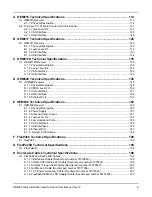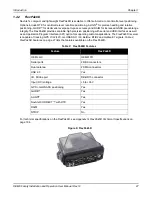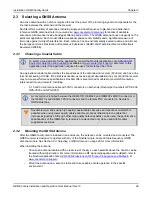
OEM6 Family Installation and Operation User Manual Rev 12
15
Lightning Protection Installation and Grounding Procedure
What is the hazard?
A lightning strike into the ground causes an increase in the earth's potential which results in a high voltage
potential between the center conductor and shield of the coaxial cable. This high voltage develops because
the voltage surge induced onto the center conductor lags in time behind the voltage surge induced onto the
shield.
Hazard Impact
A lightning strike causes the ground potential in the area to rise to dangerous levels resulting in harm to
personnel or destruction of electronic equipment in an unprotected environment. It also conducts a portion of
the strike energy down the inner conductor of the coax cable to the connected equipment.
Actions to Mitigate Lightning Hazards
1. Do not install antennas or antenna coaxial cables outside the building during a lightning storm.
2. It is not possible to avoid over voltages caused by lightning, but a lightning protection device may be
used to shunt a large portion of the transient energy to the building ground, reducing the over voltage
condition as quickly as possible.
3. Primary lightning protection must be provided by the operator/customer according to local building codes
as part of the extra building installation.
4. To ensure compliance with clause 7 "Connection to Cable Distribution Systems" of EN 60950-1, Safety
for Information Technology Equipment, a secondary lightning protection device must be used for in-
building equipment installations with external antennas. The following device has been approved by
NovAtel Inc.:
Polyphaser - Surge Arrestor DGXZ+24NFNF-B
If this device is not chosen as the primary lightning protection device, the device chosen must meet the
following requirements:
•
UL listed, or equivalent, in country of installation (for example, TUV, VDE and so on) for lightning
surge protection
•
The primary device must be capable of limiting an incoming surge to 10 kV
5. The shield of the coaxial cable entering the building should be connected at a grounding plate at the
building's entrance. The lightning protection devices should have their chassis grounded to the same
ground near to the building's entrance.
6. The primary and secondary lightning protections should be as close to the building's entrance as
possible. Where feasible, mount onto the grounding plate itself (refer to the figure below).
Only qualified personnel, such as electricians mandated by the governing body in the
country of installation, may install lightning protection devices.
















































